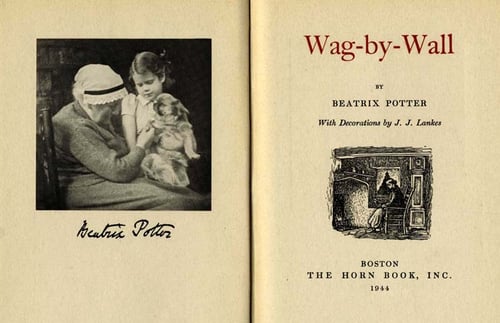We think it’s safe to assume that if you’re reading this article you enjoy books. You also probably believe, as we do, that books are important physical objects: they are important collectibles and keepsakes that you can feel, hold in your hand, page through, and examine the condition of. Indeed, we like to place an emphasis on the physical copy of a book as an object to be treasured. In our efforts to do so, we’d like to examine some of the features that make books, especially rare books, so special. Today, we’re focusing on frontispieces. What is a frontispiece? What’s with the funny name? What’s the history of this particular feature in our books? We hope this post answers these and more of your questions.
 |
| This color frontispiece from Daddy Darwin's Dovecot was illustrated by Randolph Caldecott and is one of 17 illustrations in the book. |
What is a Frontispiece?
Merriam-Webster defines a frontispiece as an illustration preceding and usually facing the title page of a book or magazine.
What is the history and origin of the frontispiece?
The word frontispiece can often confuse people. Perhaps you thought you’ve heard it used in reference to architecture. You wouldn’t be wrong. In fact, Merriam-Webster’s first definition for frontispiece is "the principal front of a building, or a decorated pediment over a portico or window." According to World Wide Words, the word frontispiece comes from the French for frontispice or the Latin for frontispicium. In both cases, the word means façade.
The word frontispiece was introduced into the English language in the late 1500s but retained the French frontispice spelling. No later than 1607 did frontispiece take on a meaning associated with books. The coalescence of these words and the ideas behind them makes much more sense when you consider that early frontispiece illustrations often depicted architectural features, pillars, and so forth. These illustrations were actually on the title page itself. By the late 1600s, the inclusion of a facing page with illustrations assumed the moniker of frontispiece, and the rest, as they say, is history.
What’s the purpose of a frontispiece?
Frontispieces are decorative in nature. To be sure, they look good in collectible books. They can serve to reflect the theme of the story for which they are included. Or, for less expensive books, they can be stock images. In some cases, a frontispiece illustration is another chance to see the work of a legendary illustrator commissioned for the work. In other cases, frontispieces contain intricate woodcuts. Often, frontispieces depict the image of the author or the subject of a biography, as in The Story of Gladstone's Life by Justin McCarthy. In many cases, especially in books published in the mid-late 1800s, frontispieces with images of the author are also a likely place to find facsimile signatures.
 |
| This is a tipped-on frontispiece photograph of Beatrix Potter and child with her facsimile signature underneath on half-title verso in Wag-by-Wall. |
In some instances, a frontispiece is supremely important in conveying information and extra details about the book itself, the time period in which it was written, or the subject it explores. For example, the frontispiece of the Codex Mendoza, Viceroyalty of New Spain, c. 1541–1542 reveals and supports information known about the Aztec capital, Tenochtitlan, which is below modern-day Mexico City. Since the capital can’t be seen presently, the frontispiece’s depiction of the division of the city into four parts, separated by blue-green lines indicating water canals is all the more useful in corroborating other information about the capital and its makeup. Likewise, the other symbols depicted on this particular frontispiece—things like crops, items of war, temples, etc.—reveal important details about the life of the Aztec people. You can see the frontispiece for yourself here.
Sources: Merriam-Webster, Khan Academy, World Wide Words









